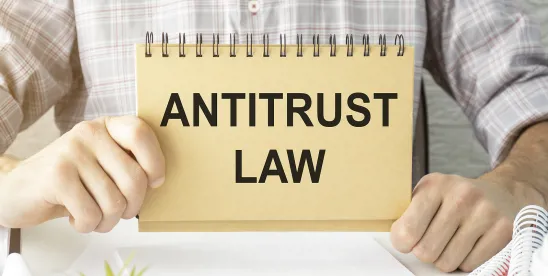On October 10, 2024, the Federal Trade Commission (“FTC”), with the concurrence of the Department of Justice (“DOJ,” and together with the FTC, the “Agencies”), adopted final changes to the form, instructions, and rules governing premerger notification filings (the “Final Rules”) pursuant to the Hart-Scott-Rodino (“HSR”) Act. The rule changes followed the FTC’s issuance of proposed rules in June of 2023 (the “Proposed Rules”) and a public comment period. The Proposed Rules would have substantially expanded the amount and the nature of information that parties to a reportable deal would have to provide to the government. While the Agencies explained that the additional information would allow their initial review of mergers to be more efficient and effective, some of the public comments expressed concern regarding the impact of increasing the burden on transacting parties. In the Final Rules, the Agencies meaningfully scaled back the requirements of the Proposed Rules, but many – though not necessarily all – HSR filings are likely to require significant, additional time and expense. For this reason, parties who are contemplating a transaction should consult antitrust and HSR counsel early in the process and allocate additional time to the HSR filing process. What follows is a high-level summary of the changes that will be made when the Final Rules become effective, which will likely be in mid-January 2025.
Key Information that Must Be Submitted
- Additional Documents: The Final Rules will require filers to submit two main categories of “Business Documents,” which will be known as (1) “Transaction-Related Documents” (formerly referred to as “Item 4(c)” and “Item 4(d)” documents); and (2) “Plans and Reports.”
- Transaction-Related Documents: While the current rules require filing parties to submit certain transaction-related competition documents – formerly referred to as “Item 4(c)” documents – only if they are prepared by or for an officer or director, the Final Rules will additionally require the submission of such documents if they are prepared by or for the “supervisory deal team lead.” The “supervisory deal team lead” is “the individual who has primary responsibility for supervising the strategic assessment of the deal, and who would not otherwise qualify as a director or officer.” Parties should identify this custodian early in the process. Documents formerly referred to as “Item 4(d)” documents, including confidential information memoranda, certain third-party reports, and synergies documents, will still be required. The Final Rules also clarify that drafts of transaction-related documents will be required if they are shared with any member of the Board, as opposed to the whole Board. Drafts of all transaction-related documents would have been required under the Proposed Rules.
- Plans and Reports: Under the Final Rules, a new category of documents known as “Plans and Reports” will be required. These documents include ordinary course plans and reports discussing market shares, competition, competitors, or markets of any overlapping product of service that were prepared or modified in the year preceding the filing. These documents will be required if they are provided to the CEO on a regular basis or if they are provided to the Board of Directors. The Proposed Rules would have required Plans and Reports if they were submitted to anyone reporting directly to the CEO, but the Final Rules dispensed with that requirement.
- Brief Descriptions: The new HSR form requires brief descriptions of the deal rationale as well as the parties’ overlapping products and services and supply relationships. The descriptions must include discussion of any pre-revenue products and services that compete with or could compete with a current or known planned product or service of the other party. For each overlapping product or service, filers must also provide sales in dollars for the most recent fiscal year, a description of all categories of customers that use the product or service, and a list of the top 10 customers and the top 10 customers in each customer category in the most recent fiscal year. While the Proposed Rules would have required filers to provide customer contact information, the Final Rules do not. Highlighting the Agencies’ increased focus on vertical relationships, in a new section about “Supply Relationships,” filers must describe and provide sales data for each product, service, or asset that is the subject of a supply or licensing agreement between the acquiring and acquired parties or between one of the parties and a competitor of the other party, subject to a de minimus
- Prior Acquisitions: Consistent with the Agencies’ increased focus on roll-up strategies and serial acquisitions, both the acquiring and acquired parties will be required to disclose acquisitions relating to overlapping products or services from the preceding 5 years, subject to a de minimus Under the current rules, only the acquiring party is required to disclose prior acquisitions. The Proposed Rules would have extended the lookback period from 5 years to 10 years and eliminated the de minimus exception.
- Interlocking Directorates and Information Exchange: The Final Rules will require the identification of the officers and directors within the acquiring entity and entities directly or indirectly controlled by or which control the acquiring entity that also serve in those roles at any entity that derives revenue in the same NAICS code as the target, at the time of filing. The acquiring person will also have to disclose, for all entities within the acquiring person that are responsible for the development, marketing, or sale of products or services that are identified as overlaps or as supply relationships, all current officers and directors and those who have served in one of those positions in the past three months that also serve in one of those positions of another entity that derives revenue in the same NAICS code as the target. While the Proposed Rules would have required similar reporting for board observers and for officers and directors within the acquired entity, the Final Rules do not. The Final Rules also shortened the lookback periods that would have applied to these requirements under the Proposed Rules.
- Subsidies from Foreign Entities or Governments of Concern: Under the Final Rules, filers will have to disclose any foreign subsidies received in the preceding two years from any “foreign entity or government of concern,” the definition of which is based on Section 40207 of the Infrastructure Investment and Jobs Act (42 U.S.C. § 18741(a)(5)). There is no de minimus exception.
- Defense or Intelligence Contracts: Filers will also have to disclose any pending requests for proposals or awarded procurement contracts with the United States Department of Defense or any member of the United States intelligence community, as defined by 10 U.S.C. § 101(a)(6) or 50 U.S.C. § 3003(4), valued at $100 million or more, if they relate to any overlapping product or service or supply relationship.
- Ownership Structure: Under the Final Rules, acquiring entities must provide a description of their ownership structure and, for fund or master limited partnerships, an organizational chart, if one exists. The Proposed Rules would have imposed the description requirement on acquired entities and would have required funds and master limited partnerships to create an organization chart if one did not exist.
- Minority Shareholders and Interest Holders: The Final Rules expand the requirements to disclose minority shareholders and interest holders. These changes will primarily impact private equity clients, but may also impact other types of businesses as well.
Effective Date and Procedural Changes
- Effective Date: The Final Rules will likely go into effect in mid-January of 2025. Parties with pending or expected future transactions should consult counsel about timing and consider accelerating an anticipated HSR filing.
- Early Termination: The HSR Act imposes a 30-day mandatory waiting period for most transactions, during which time the parties are unable to close their deal. In the past, in cases where the Agencies determined that they would not take enforcement action prior to the expiration of a waiting period, the Agencies would terminate the waiting period and allow the parties to proceed with the transaction. In 2020, the Agencies temporarily suspended the practice of granting early termination. However, with the Final Rules, the FTC announced that early termination will be restored. This change may allow some deals to close sooner.
- Filing on a Preliminary Agreement: Parties are still allowed to file on the basis of a preliminary agreement, such as a letter of intent, but these filers may be required to submit additional information if the preliminary agreement does not contain sufficient level of detail about the transaction.
- Withdraw and Refile: In some cases, it may be appropriate for an acquiring party to “pull” its HSR filing and “refile” it. This step restarts the mandatory waiting period, effectively “extending” it, without incurring a new filing fee. Under the current rules, a refiling party must submit, along with other updated information, updated financial information. Under the Final Rules, a refiling party will no longer be required to submit updated financials, but must still submit updated transaction-related documents, updated transaction agreements, and updated information about subsidies from “foreign entities of concern.”
Other Noteworthy Changes from the Proposed Rules
- Information that Is Not Required:
- Parties will not be required to submit the employee information that the Proposed Rules would have required, but the Final Rules provide that the Agencies will nevertheless consider effects on labor markets.
- Filers will not be required to report NAICS codes for certain pipeline or pre-revenue products, though they will have to describe planned products or services that could compete with those of the other party.
- Parties will not be required to submit a narrative timeline of key dates and conditions for closing the transaction.
- The Agencies will not require latitude and longitude information for street addresses.
- Finally, filers will not be required to certify that they took steps to preserve documents, but the FTC reminded the public of the obligation to preserve documents once there is a reasonable anticipation of a government investigation or litigation, which obligation could arise before or after an HSR filing.
- Lower Burden for Some Filers: There may be a lower burden for some parties in some cases, particularly where there is no overlap or supply relationship. In those cases, parties may be able to forgo providing an overlap description, a supply relationships description, officers and directors, plans and reports, prior acquisitions, and other information that relates to overlaps and supply relationships. Acquired persons will also be excused from the requirements to disclose minority shareholders (with some exception), the ownership structure description and chart, the party’s officers and directors, a transaction diagram, and certain other information that is either unnecessary or duplicative of information the acquiring person will be required to supply.
Key Takeaways
The above is merely a summary of key changes to the HSR form, instruction, and rules. There are many other changes that we have not summarized here. Given the extent of the changes, parties would be well advised to consult counsel on HSR and antitrust related issues as early on in the transaction process as possible. Other early steps may include identifying a supervisory deal team lead and identifying any overlaps or supply agreements. Further, parties should carefully consider the time needed for an HSR filing when drafting transaction agreements with clauses relating to timing.






 />i
/>i
